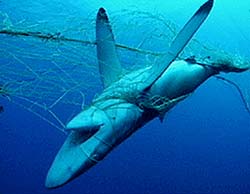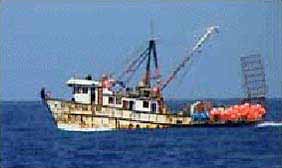
|
|
|
|
|
|
Shark Info (06-01-2000) |
Author |
|
Intro: |
Mexico: Poachers slaughter thousands of sharks in underwater park |
Shark Info |
Main article: |
Mexico: Drift net poachers slaughter thousands of sharks in unique underwater park |
Shark Info |
Article 1: |
Dr. A. J. Godknecht |
|
Article 2: |
Dr. E. K. Ritter |
|
Article 3: |
Shark Info |
|
Fact Sheet: |
Dr. E. K. Ritter |
|
Mexico: Drift net poachers slaughter thousands of sharks in unique underwater parkReport by Shark Info The Revillagigedo ArchipelagoThe Revillagigedo Island Marine Reserve is the only national underwater park of its kind in Mexico. Founded six years ago, it comprises the entire Revillagigedo Archipelago with its four islands, the most well-known being San Benedicto. The archipelago is located approximately 400 km south-southeast of Cabo San Lucas (Baja California) in the Pacific and can only be reached by ship from the mainland. The park was famous for its abundant shark populations and has been frequented by the largest mantas in the world (with weights up to 2 tons). Besides its reputation as being a playground for numerous sharks and mantas, the islands are also a refuge for various threatened species of birds, and the archipelago's biosphere is often called "Mexico's Mini-Galapagos". Scuba divers from around the world are attracted to the park like a magnet and the income stemming from diving tourism is estimated to reach at least USD 2 million annually. Valentine's Day MassacreFebruary 14, 1994, marked a sad event in the history of the archipelago as fishing vessels appeared off the coast of San Benedicto and began to slaughter manta rays and sharks. This incident became known as the Valentine's Day Massacre and not only triggered the foundation of the Revillagigedo Park, but also resulted in mantas being placed on the list of endangered species in Mexico. Today the catching or killing of a manta is fined with up to USD 10,000.
Another massacreRecently, on May 2, 2000, another massacre occurred in the Revillagigedo Archipelago - but this time in the protected underwater park and on a gigantic scale. It was witnessed and documented by divers on two boats who drew attention to the massacre. Coming from Cabo San Lucas, the people on board the Ambar III and Solmar V noticed seven fishing boats put out drift nets in the waters around the islands, despite a law which prohibits fishing within the 12-mile zone around the islands and even requires scuba divers to obtain a special permit to dive within this zone. One of the captains of the two submersibles, Mike McGettigan, is founder of SEAWATCH, a private organization stationed in Oregon, USA, whose objective is to protect the Sea of Cortez between Baja California and the Mexican mainland. SEAWATCH distributes information in Mexico, the U.S. and the remaining world in order to prevent the destruction of the Sea of Cortez. McGettigan immediately called in officials and documented everything that happened on video.
The seven fishing vessels, with a total water displacement of approximately 70 to 90 tons and each equipped with more than 3 km of drift nets, were recorded and filmed. Later interrogations of the crews revealed that the boats had fished within the park boundaries for 4 to 5 days, sometimes only 400 m offshore! Divers could identify five of the seven boats, including the Victor M. Calzas, the Macapule III, the Mazatleco, the Tiburon Maco and the Nino and even managed to film the massacre both above and underwater.
Based on this video documentation approximately 2,000 to 4,000 sharks were pulled on board the boats and finned. Sea turtles and other sea animals were also captured. The Nino was filmed as it pulled in its nets over Bolder Rock, a high underwater pinnacle which reaches down to great depths and rises practically to the water's surface. Bolder Rock lies only approximately 400 m off the coast and is a gathering point for the world's largest mantas such as those filmed in the nets of the Nino. The massacre was extensive and destroyed a unique underwater world. Divers on the scene reported seeing no living sharks in the area afterwards. No reaction from public authorities despite existing lawsAlthough the video reports on the May 2nd massacre were submitted to the Mexican
Government, no charges have as yet been brought against the poachers. Protecting the archipelago is not an easy undertaking for Mexican authorities. The islands are located 400 km from the mainland and insufficient resources are available to adequately control the region which is uninhabited except for an outer post maintained by the Mexican navy in Socorro, the largest of the four islands located approximately 60 km from San Benedicto. The most effective protection is thus still provided by divers and American yachts which frequent this park on a regular basis. No hope for the sharksConsidering the slow reproduction rate of sharks, the Revillgigedo Islands have probably lost their large and diverse shark populations and hence their uniqueness for a very long time to come. And even if shark populations should one day recover from this decimation, they will need protection instead of only vague declarations of intent or excuses from the responsible ministries who with their lax attitude directly encourage poaching by unscrupulous fishers. May be published only by indicating the source: Shark Info |
|
|
|
|
|
|||||


